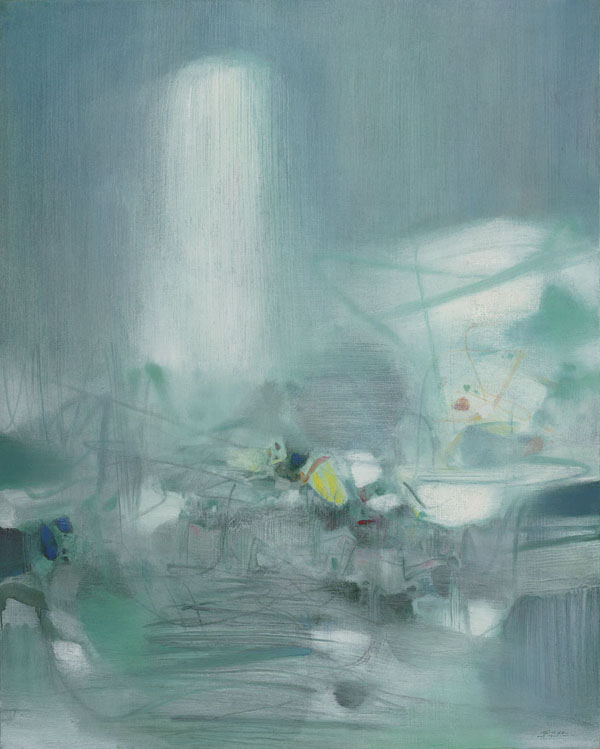From 1985 onwards, Chu Teh-chun created a whole series of oil paintings showing magnificently expressive winter-style vistas subsumed under the collective title "Snowscapes." Marking a new peak in the artist's career, these pictures made increased use of the "feibai" technique typical of traditional Chinese painting and calligraphy: ink, or color, is applied in a kind of scumble with a dry or half-dry brush. Chu now perfected his ability to employ such soft, hollow strokes to generate abstract imagery in oil. In this lot, completed in 1884 and titled "Composition 1984," the palette is dominated by cool pastels of white and various shades of green and blue, anticipating Chu's later development of his distinctive style of "white lyricism." As far as use of color was concerned, the early 1980s saw a major breakthrough in Chu's art as he experimented with a wide range of hues and tones to evoke images of churning chaos, aiming to capture the essence of life as it springs from the heart of our cosmos. At the same time, however, his vacillating output from that period also includes more pastoral works featuring sublimated scenery bathed in a gentle and idyllic light.
The late Li Lin-tsan, one of Chu's classmates and good friends at the Hangzhou National College of Art, once recalled that back in those days, Chu Teh-chun was one of the most eager and industrious students, and was always working on some picture to improve his skills. In particular, he would try to capture the elusive "silver grey tones" of the West Lake scenery at sunrise and dusk. When Li met Chu again in the 1980s, he found his friend had already moved on from representational painting to abstract visualizations, and marveled at his expansive flair and exceptional aptitude for depicting infinite panoramas, vast and free.
In 1985, Chu Teh-chun gave an interview to Taiwan art and literary critics Cheng Ming and Chu Ko, in which he talked about the insights he had gained from painting. His words very much reflect the confidence and maturity he had achieved at that point in his career, "My experience was that as a young artist, I knew that what I wanted to paint were my impressions and feelings, yet knowing this and actually doing it were two very different things! It was hard in the beginning, and all I did at first was to strive to express myself through the simple use of color and lines. I did this to the point of exhaustion, and although this approach would—as if by chance—yield the occasional good work, it would take me half a year, or even a whole year, before I would gradually reach the point at which I was capable of putting my ideas on canvas in a genuine and authentic fashion. In this way, I worked for about 20 years, but now I have finally attained a level at which I'm comfortable with working in a much faster, more focused manner. It comes easy now, and naturally, and I can express everything, even the subtlest nuances, with fluid and unrestrained brushstrokes: I have gained unlimited creative freedom." (Liao Chiung Fang, Overseas Chinese Fine Arts Series II: Chu Teh-chun, Artist Publishing Co., Taipei, 1999, pp. 56-57)
The abstract piece "Composition 1984" is teeming with the enigmatic "silver grey tones" that Chu was attempting to paint in his youth, conveying all the crystalline beauty and undulating charm of water surrounded by green hills through the prism of his keen and deeply artistic perception, tempered and enhanced by a finely-honed sense for beauty. Free-flowing yet convoluted lines and strokes, highly reminiscent of Chinese calligraphy, lend structure to the composition and a gently throbbing rhythm to the colors. Translucent "feibai" strokes create a wonderfully captivating mood, as if one was lost in the mesmerizing glimmer of stars slowly fading in the dawn. "When I paint, I express my travel experiences on canvas. Some of the paintings are about an impulse I couldn't restrain at the time; some of them are about travel memories from a long time ago, or even forgotten ones that were brought back into memory by working on the canvas. It doesn't matter whether my creative urge is stimulated by the beautiful sights I've seen, or old memories and emotions well up inside of me, as long as I'm in front of the canvas, my sensitivity will be kindled. As if I were drinking wine, I will passionately draw my fresh first sip with passion—on the canvas. Maybe I'll apply the second or third layers of paint in one go, but normally I just hang the canvas on the wall, and look at it from a certain distance, before I set about refining the picture, or renewing and modifying it. In my opinion as a painter, the first paint determines the destiny of the entire work, and in its application one can glimpse the genius of the artist. But the second paint, that tells you everything about the artist's skill and experience." (ibid., p. 57)
During the 1980s, Chu Teh-chun introduced more and more elements of traditional Chinese painting and calligraphy into his work, using vigorous yet elegant lines and dots, as well as hooked, tilted and broadly sweeping strokes to express increasingly subtle shades of natural light and shadow. Especially towards the end of that decade, the artist further enriched and expanded his palette, and daringly explored even wider and more profound spiritual landscapes that are both powerful in their appeal and delicate in their execution. The works of that period, including this lot, firmly established Chu as a master of expressive lyricism in painting.
